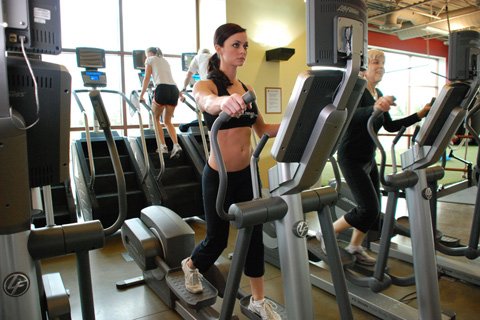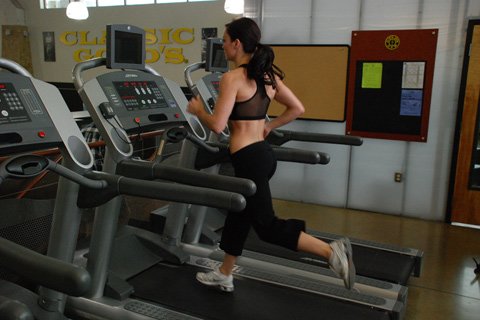One year in college I was injured and had to cross-train every day of the week to prepare for our 3-mile races on Saturdays. For six days a week the only thing I did in running shoes was walk around campus or ride my bike.
Because I was completely out of the whole training specificity thing (train with the same movements you'll you use in your sport—i.e. run to get better at running), I knew I had to train hard on the bike and in the pool. So, I bought a heart rate monitor and I've been hooked ever since. If you want to lose weight, get ripped, get faster or improve your conditioning, a heart rate monitor is a tool you should not live without.
What Is A Heart Rate Monitor?
A heart rate monitor is just that, it measures your heart rate at rest, during exercise or whenever you wear it. But, today's heart rate monitors can do a whole lot more then just measure your heart rate:
- You can set them to beep at you when you are out of your target range. Because there's nothing like a constant beep to tell you to move faster.
- Most, if not all, give you your average heart rate for a bout of exercise.
- Some measure calories burned (remember, this is an estimate and may not reflect your true calories burned).
- Some come with software that helps you analyze your training and plan upcoming training sessions accordingly. And, some have the ability to download data into other training programs so your coach can analyze it.
- Heart rate monitors especially made for cyclists provide cycling specific data.
- Some provide your location based on GPS.
How A Heart Rate Monitor Can Help You Train Better
Heart Rate Monitors Automatically Read On Machines
No doubt you've seen the heart rate monitors on machines in the gym. However, if you are running on a treadmill with your hands on the monitors to get your heart rate, I can guarantee one of two things:
- You aren't running fast enough or
- You are really messing up your gait.
By wearing a heart rate monitor though, you will constantly see your heart rate on machines in the gym without holding the handles and waiting.

 Click To Enlarge.
Click To Enlarge. By Wearing A Heart Rate Monitor You Will Constantly See Your Heart Rate On Machines In The Gym Without Holding The Handles And Waiting.
You Can Train Within A Target Zone Without Slacking
I'm sure you've seen them. The people in your gym with no pedals on the bikes (wouldn't want to engage our hamstrings too much now would we) who are slowly pedaling while reading a magazine or book or chatting on the phone. Sure, they are in the "fat burning zone" where they are burning a greater percentage of their calories from fat.
However, they are also burning very few calories. And, if you are going to workout, why not get the most bang for your buck? If you want to burn just a few calories, wouldn't it make more sense to do this while taking a scenic stroll in a park instead of reading a torn up magazine in a crowded gym?
Heart Rate Monitors Can Help You Shed Fat Faster
Work harder and longer and you'll burn more calories. Engage in interval training or high intensity interval training and you can cut your total aerobic time down and get better results. You'll improve your cardiovascular fitness and shed body fat (time to nix the whole "fat burning zone") faster.
You can alter your interval time and rest period depending on what you want to achieve and your state of fitness.

 Click To Enlarge.
Click To Enlarge. Engage In Interval Training Or High Intensity Interval Training And You Can Cut Your Total Aerobic Time Down And Get Better Results.
Heart Rate Monitors Can Help You Train
By downloading your heart rate data, you or your coach can determine if you are on target with your training or overtraining (a higher than usual heart rate can be an indicator of overtraining).
Additional Tips On Heart Rate Monitors
- You probably don't need the top of the line model unless you are training for a race.
- Choose a heart rate monitor that fits your needs—there are some made for cycling, running and multi-sport athletes.
- If you tend to get lost in your own neighborhood, choose a heart rate monitor with a GPS built in.
- Determine your Training Zone. First, estimate your maximum heart rate (220 - age; or some heart rate monitors have this built in). Next, find the specific training zone that you want to train in (the percentages are based off your maximum heart rate):
60-70% - low intensity exercise
70-80% - medium intensity exercise
80+ - high intensity exercise - Keep in mind that each individual is different and his or her response to training will vary as well. Some people can get their heart rate up very high whereas others may feel like they are exerting themselves and their heart rate doesn't increase (beta blockers and other medicines effect your heart rate response). In addition, stress illness, overtraining, fatigue, time of day, food or drink, altitude, body temperature, hydration status and weather conditions all affect your heart rate.
If you do any type of aerobic exercise or have a history of heart problems, invest in a heart rate monitor. I promise you'll be hooked and achieve better results faster by monitoring your heart rate during exercise.
Note: If you have a heart condition, chest pain, feel dizzy or sick during exercise or have any medical condition, consult with your physician prior to substantially increasing your physical activity.
About the Author:
Marie Spano is a leading authority on translating the latest nutrition and exercise science research into real life applications. Ms. Spano has also helped pro athletes and Fortune 500 executives enhance their health and performance through sound nutrition practices. She is a regular contributor to bodybuilding.com.
For more information see: www.mariespano.com
References:
- Selectively and Effectively Using Heart Rate Monitors. ACSM brochure.
- Journal of the International Society of Sports Nutrition 2009, 6 (Suppl 1):P16.
